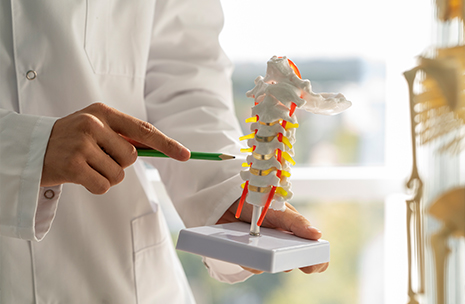
Spondylolisthesis
Spondylolisthesis is the slippage of one vertebral body with respect to the adjacent vertebral body causing mechanical or radicular symptoms or pain. It can be due to congenital, acquired or idiopathic causes. Spondylolisthesis is graded based on the degree of slippage (Meyerding Classification) of one vertebral body on the adjacent vertebral body.
Etiology :
- Repetitive stress to the pars interarticularis
- Decreased strength of the neural arch at a young age predisposes children and adolescents to a higher risk of fracture.
- Traumatic accidental injuries
- Microtrauma in sports
- Pathological causes – Neoplasm, connective tissue disease, etc.
- Iatrogenic – After laminectomy
- Adolescents and children also have more elastic intervertebral discs which cause increased stress to be placed on the pars interarticularis
Classification :
- Wiltse Classification: It has five major etiologies: degenerative, isthmic, traumatic, dysplastic, or pathologic.
- Dysplastic spondylolisthesis (Type 1) is congenital and secondary to variation in the orientation of the facet joints to an abnormal alignment. In dysplastic spondylolisthesis, the facet joints are more sagittally oriented than the typical coronal orientation.
- Isthmic spondylolisthesis results from defects in the pars interarticularis. The cause of isthmic spondylolisthesis is undetermined, but a possible etiology includes microtrauma in adolescence related to sports such as wrestling, football, and gymnastics, where repeated lumbar extension occurs. Type II is isthmic and is separated into Type IIA and Type IIB. Type IIA is caused by a stress fracture of the pars interarticularis (spondylolysis) that results in anterior slippage of the vertebrae. Type IIB is caused by repetitive fractures and subsequent healing which results in lengthening of the pars interarticularis leading to anterior slippage of the vertebrae.
- Degenerative spondylolisthesis (Type 3) occurs from degenerative changes in the spine without any defect in the pars interarticularis. It is usually related to combined facet joint and disc degeneration leading to instability and forward movement of one vertebral body relative to the adjacent vertebral body. Arthritis of the facet joint which in turn causes weakness of ligamentum flavum leads to anterior slippage of the vertebra.
- Traumatic spondylolisthesis (Type 4) occurs after fractures of the pars interarticularis or the facet joint structure and is most common after trauma.
- Pathologic spondylolisthesis (Type 5) can be from systemic causes such as bone or connective tissue disorders or a focal process, including infection or neoplasm.
- Iatrogenic spondylolisthesis (Type 6) is a potential sequela of spinal surgery. Frequently, these patients will have undergone prior laminectomy.
Signs And Symptoms :
- Patients typically have low back pain which mimics radiculopathy for lumbar spondylolisthesis and localized/radiating neck pain for cervical spondylolisthesis.
- Pain is exacerbated by extending at the affected segment, as this can cause mechanic pain from motion, leading to diminished ROM (spine). Pain decreases as the patient assumes flexed posture which reduces stress on the nerve being impinged.
- Pain may be exacerbated by direct palpation of the affected segment.
- Pain can also be radicular in nature as the exiting nerve roots become compressed due to the narrowing of nerve foramina as one vertebra slips on the adjacent vertebrae. The traversing nerve root (root to the level below) can also be impinged through associated lateral recess narrowing, disc protrusion, or central canal stenosis.
- Pain can sometimes improve in certain positions such as lying supine. This improvement is due to the instability of the spondylolisthesis that reduces with supine posture, thus relieving the pressure on the bony elements as well as opening the spinal canal or neural foramen.
- Spondylolisthesis can also present as an acute or acute-on-chronic episode with the patient having severe exacerbation of pre-existing back pain, neurological deficits, hamstrings spasm, and a crouched gait. The patient develops a crouched gait (Phalen-Dickson sign) due to the vertical position of the sacrum, lumbosacral kyphosis, compensatory lordosis of the proximal spine, and flexion of the knees and hips, which may be present regardless of the degree of slippage.
- Atrophy of the muscles, muscle weakness.
- Tense hamstrings, hamstrings spasms.
- Disturbances in coordination and balance, difficulty walking.
- Rarely loss of bowel or bladder control.
Treatments :
- Abhyangam
- Tractions
- Lepanas
- Bandage
- Katee vasti
- Swedam
- Sneha vasti
- Kashaya vasti

